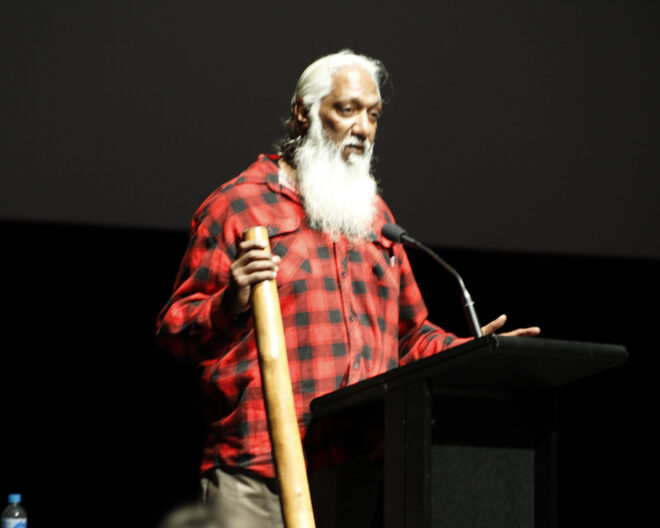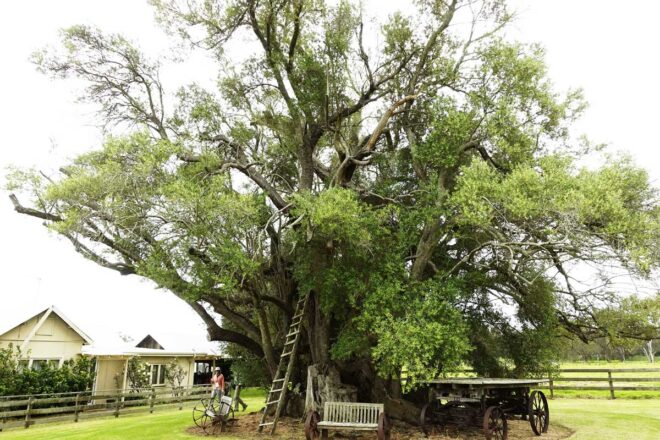View of Koombana Bay on Port Leschenault, Australind, Western Australia, drawn and lithographed by TC Dibdin, from an original sketch taken on the spot by Miss Louisa Clifton, image National Library of Australia
Hesperia: Looking West
John Viska, the conference convenor, explained in an article in Australian Garden History (vol 35. no. 4) the term ‘Hesperia’. This was the name contemplated by Captain James Stirling for the British settlement on the Swan River established in 1829, Hesperia coming from Hesperus, the Greek name for the god of the west wind. Hesperia was not adopted, with the name the Swan River Colony used until it became officially Western Australia in 1832.
The 44th annual conference was held in Bunbury (get the conference program here), with conference goers greeted by the Mayor Jaysen Miguel and Deputy Mayor Tresslyn Smith. Noongar tour guide and artist, Troy Bennell, gave the Welcome to Country.

Day one (18 October 2024)
The first lecture session covered the early colonial history of Bunbury, as well as contemporary developments being undertaken by the Noongar Land Enterprise Group, particularly in the southwestern area of Western Australia. In the second session, Bernice Barry spoke of Georgiana Molloy. Barry has studied Molloy’s personal letters (see A Lady’s Pen, UWA Press) to reveal more about this early botanical collector, who also made gardens in Augusta and Busselton. The latter were the focus of Barry’s talk. John Viska spoke about the many plants cultivated today in Western Australia that had their origins in South Africa.
In the afternoon, delegates visited Alverstoke, a farm complex established in 1842 by Marshall Waller Clifton (his daughter, Louisa, drew the image of Koombana Bay above). They then went to Leschenault Homestead and to St Mark’s Anglican Church at Picton, both sites with remnants of wattle and daub buildings and grand trees.

Day two (19 October 2024)
The first lecture of day two was by Peter Lane who provided a lucid account of the geology of Australia’s south west. His book on the subject is Our Planet and the Evolution of Western Australia’s Far South West. Rod Cary gave a brief history of viticulture; Edgar Hawter spoke about his forebear Jacob Hawter, a nurseryman in the region; and Margaret Sanders introduced the work of Louisa Clifton, whose drawings of the Bunbury landscape provide us with an idea about life in the early settlement.
Delegates were hosted in Dardanup by members of Saint Aidan’s Church, who had laid tables with floral arrangements and provided homemade fare to accompany boxed lunches. A scenic drive through the Ferguson Valley brought delegates to Tranquil Gardens, a large property established by Dianne and Wayne Webster where many of their great variety of plants were in glorious flower.

Day three (20 October 2024)
Greg Keighery was the first lecturer on day three. He spoke about John Oldham, appointed Western Australia’s first Government Landscape Architect in 1959. Greg discussed Oldham’s philosophical approach to landscape design, which those delegates who visited the Wellington Dam precinct on 21 October were able to see: the creation of parkland bush gardens using native plants so that public spaces were accessible to the people.
Des Donnelly discussed the struggles volunteers are having to save tuart forest areas under threat from land clearing, urban expansion and introduced weeds such as the arum lily. The last speaker at the conference was Yolanda Cool who showed how conversations and persistent networking were succeeding in building awareness of the importance of heritage skills in the effort to conserve historic places and their gardens. (Australia ICOMOS has a heritage skills education reference group.)
On a wet afternoon, delegates visited Wonnerup House, dating from 1859,; Caves House at Yallingup with its typical early 20th-century garden; and Fire and Beauty, a fire-resistant garden created in the 1990s using primarily succulents.



